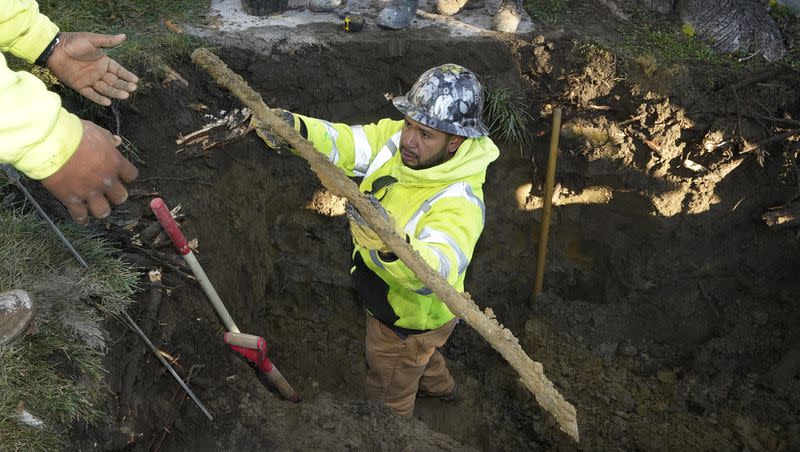New EPA proposal would require all lead water pipes in the U.S. be replaced

The Environmental Protection Agency wants all lead pipes in the U.S. water system to be replaced within the next 10 years to protect public health from the neurotoxic effects of the heavy metal.
In a news release, the EPA said the proposal “would accelerate progress toward achieving President Biden’s goal of removing 100% of lead pipes.”
Besides requiring water systems to replace lead pipes, the EPA proposal would lower the lead level at which corrective action is required, and improve how water systems sample their water for lead.
The EPA said the undertaking could cost $45 billion. But, as The Washington Post reported, “The costs of lead exposure are also high. Lead can cause irreversible cognitive damage and other health problems, even at low levels, and particularly in small children. Despite the significant health threat, cities have struggled to get rid of the estimated 9 million lead pipes that remain. And the federal government has never required their total replacement.”
“This is a public health concern that has unfortunately spanned generations,” EPA Administrator Michael Regan told reporters in a press briefing Wednesday. “Our proposed improvements are a major advancement.”
Water utilities would have 10 years to replace the pipes, but they couldn’t put it off. Rather, they’d be required to do at least 10% a year until the job was finished.
“Get the Lead Out” is the effort’s slogan, and it’s backed by the $15 billion investment in the bipartisan infrastructure bill. “The Lead and Copper Rule Improvements are central to the whole of government approach detailed in the administration’s Lead Pipe and Paint Action Plan,” the EPA reported.
As the Post noted, the plan doesn’t say who would pick up the rest of the bill. The Association of Metropolitan Water Agencies told the Post that customers might have to make up the difference through increased water bills.
Expensive either way
Officials say the improvements are well worth the cost, since not dealing with lead is also very expensive.
“Lead in drinking water is a generational public health issue, and EPA’s proposal will accelerate progress towards President Biden’s goal of replacing every lead pipe across America once and for all,” Regan said. “With collaboration and the focused actions proposed today, EPA is delivering on our charge to protect all Americans, especially communities of color, that are disproportionately harmed by lead in drinking water systems.”
The Centers for Disease Control and Prevention and other health experts emphasize that there is no safe level of lead exposure, which is terrible for children in particular. It hampers mental and physical development and can damage the brain, leading to learning disabilities, developmental delays, hearing and speech problems. It can lower IQ. Lead exposure for adults can cause high blood pressure and heart disease, as well as kidney damage and certain cancers.
Related
Many people became more aware of the dangers of lead in water when during 2014 and 2015 excessive levels of lead contamination in water in Flint, Michigan, became a national and protracted story after the city changed its water source, leading to lead at high levels in the water for over a year.
Per The New York TImes, “In the wake of the Flint crisis, the Trump administration required schools and day care centers to test for lead in their drinking water and ordered water utilities to conduct inventories of their lead service pipes and publicly report their locations. But the administration also doubled, to 30 years, the amount of time that utilities could take to replace lead pipes.”
The proposed rule change “could have a dramatic effect in Chicago, Cleveland and New York, which, according to the Environmental Defense Fund, have the most lead pipes of any cities in the country. Because of the enormous amount of work to be done, these cities may be given more time under the proposed rule, which exempts water systems from the 10-year time requirement if they would have to replace more than 10,000 lead service lines annually,” per The Washington Post article.
The rule will be published in the Federal Register and the EPA will take public comments for 60 days. It has also scheduled a public hearing Jan. 16, 2024, where verbal comments can be provided. More information is online at the ground water and drinking water EPA page.
Protect yourself
There are things families can do to protect themselves from lead exposure in water as well. Among others, the EPA recommends that you:
Contact your water utility about having your water tested and to see if you have a lead service line. If so, ask about service line replacement.
Run water before drinking it. Take your shower first or do laundry or the dishes.
Be aware that construction can disturb a lead service line, releasing more lead.
Use cold water for drinking, cooking and making baby formula. Hot water can contain higher levels of lead, EPA said. And boiling water just boils the lead, it doesn’t take it out of the water.
Regularly clean your faucet screen.
Consider a filter certified to remove lead.

